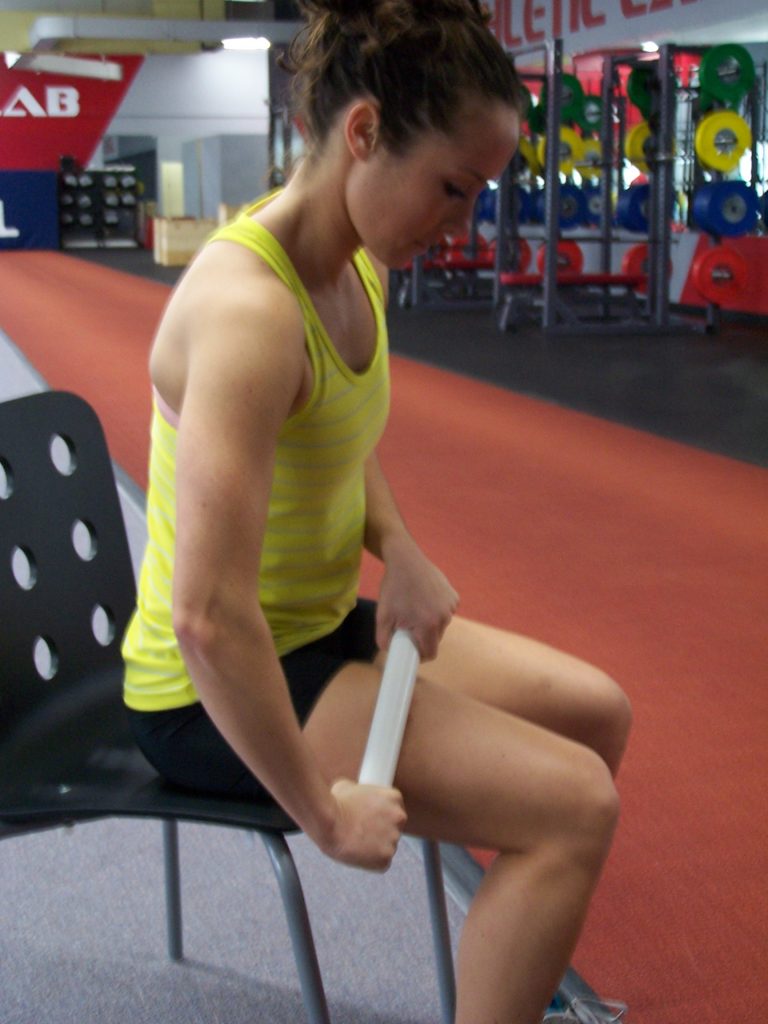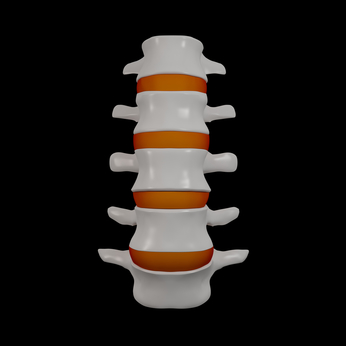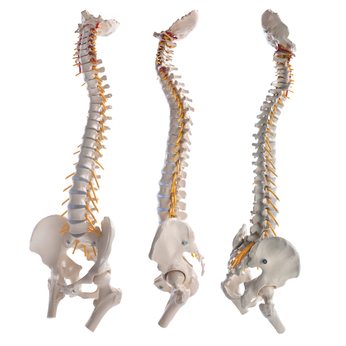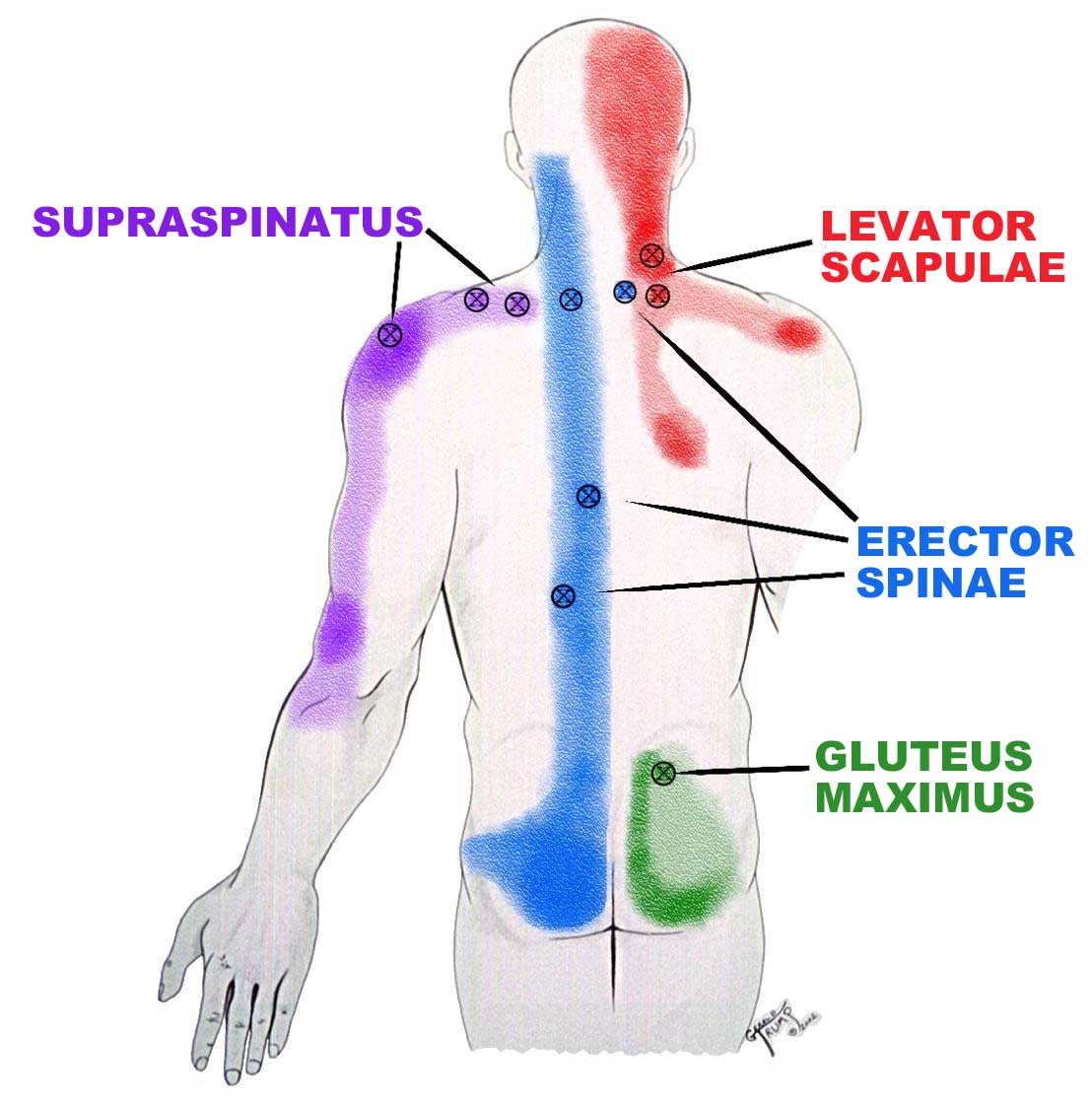What Causes Back Pain? Exploring the Overlooked Muscular Causes:
Muscles are rarely considered as one of the causes of back pain, yet they are often the key component. An understanding of how muscles impact your spine and pelvis will help clarify this oversight.
As shown in the graphic, muscle spasms (circles) will cause pain to refer to areas often far from the spasm. The shaded area shows the pain referral area.
Your back is a symphony of overlapping, interconnected, groups of muscles,tendons, and nerves. Each muscle merges into a tendon, which then crosses over a joint and inserts into a bone. When the muscle contracts it will pull on the tendon and the joint moves.
Your spine has 7 cervical vertebrae, 12 thoracic vertebrae, and 5 lumbar vertebrae. Each vertebra is separated by a gelatinous disk that acts as a cushion to separate the bones. The disks protect the vertebrae from wear. Muscles span your entire spine, in some cases originating on the vertebrae and connecting each vertebra to the next. Some muscles originate on the ribs and insert into the vertebrae, moving your spine in the infinite number of angles. Other muscles originate on your vertebrae and insert into bones such as your shoulder blade, pulling it in various directions.
To move in the opposite direction, the contracted muscle needs to relax to remove the tension on the bone. Meanwhile the muscle on the opposite side contracts to pull the bone in the opposite direction. If the muscle that needs to release is in a spasm it can’t relax, and you have the muscles pulling in two opposite directions – and you have back pain.
The answer to what causes back pain is so broad that it needs to be broken down into:
(1) Why a Muscular Component Causes Back Pain
Back pain is commonly caused by repetitively straining the muscles that insert into the vertebrae and ribs. The list of muscles that insert into the bones of your back is long, with each muscle potentially causing pain when it is in spasm and pulling on the bone. Your back is a system of overlapping muscles. When you are treating a muscle for one thing, you may also be treating the source of a different problem.

This commonly happens when you are treating a thigh muscle that causes knee pain. The same muscle frequently causes back pain, groin pain, and sciatica.
For this muscle treatment I suggest you use a 12″x 1″ length of PVC pipe. Hold it as shown and slide (don’t roll) from the top of your thigh to just above your knee. The main area of treatment is shown in this picture. It’s NOT on the front of your thigh, and it’s NOT on the outside of your thigh, but instead it is in between these two lines.
As you go down your thigh you’ll go over several “bumps.” These are actually large spasms that are pulling down on the front of your pelvis. The pelvis rotation causes a strain on your low back, and presses your posterior pelvis up into your sciatic nerve.
There’s a lot more to this muscle, but it’s so broad that it can’t be explained properly here. Each of the muscles that cause back pain are fully explained, and treatments are demonstrated in The 15 Minute Back Pain Solution.
(2) Why a Bulging or Herniated Disk Causes Back Pain

The disk between each vertebra is meant to be a cushion for the bones so they don’t rub on each other. However, tight muscles that originate on each vertebra can pull the bones together. This presses the bones down on the disks and cause them to either bulge in the opposite direction, or herniate.
For example, tight muscles on the right side of the spine will bring the vertebrae closer together on the right, causing the disk to bulge toward the left.
Tight muscles on both sides of the spine will draw the vertebrae closer together and potentially herniate the disk.
In either case the disks will put pressure on the spinal cord and cause severe back pain. However, if it is treated before permanent damage is done, releasing the muscle tension on the vertebrae will move the bones off the disk and the pain will be eliminated.
(3) Why a Vertebra Out of Alignment Causes Back Pain

Your spine stays in perfect alignment because muscles are putting the exact amount of “pull” on each side. Without muscles the spine would just hang straight and not be able to move — like a skeleton on a hook. It is only because of muscles that the spine has any mobility at all.
The only way a vertebrae moves is either by muscles pulling on the bones, or a traumatic accident. Trauma, such as falling down a flight of steps, or having a car accident, will push bones out of alignment .
If muscles are pulling on one side more than the other the vertebrae will move toward the tight muscles.
The tension in the muscles must be released first if the bones are to be moved back into alignment.
(4) Scoliosis, Osteoporosis, Spinal Stenosis, and other Causes of Back Pain
There are medical conditions such as scoliosis, osteoporosis, spinal stenosis, diabetes, and cancer that are also causes of back pain. These are serious conditions that need medical attention. Always eliminate the possibility of any serious health risks before embarking on a path of treating for back pain.
Conclusion:
Obviously, as noted in #4 above, there are medical causes of back pain. However, it is clear that the one that is consistently overlooked, and therefore not treated, is the muscular component. My experience with thousands of clients, both at my office and virtually online, is that muscles are frequently the cause of back pain. Pain can be lessened or eliminated by treating the tight muscles.
You have nothing to lose, and everything to gain, by exploring the muscular component to back pain!
Wishing you well,


